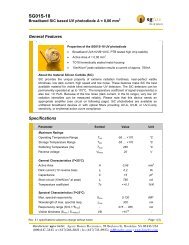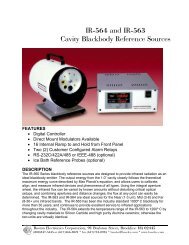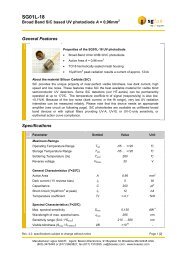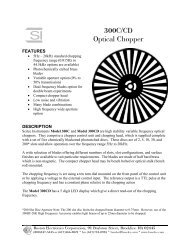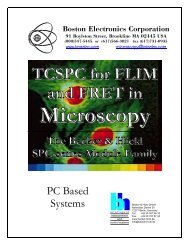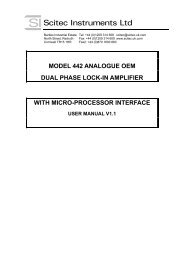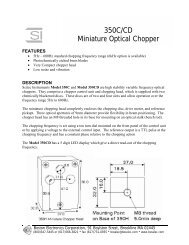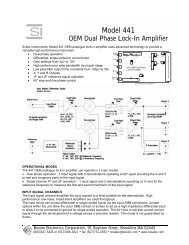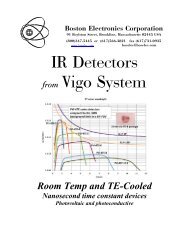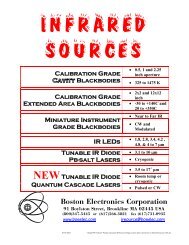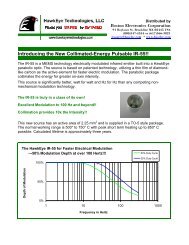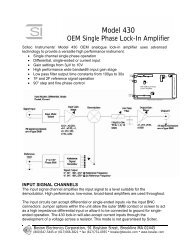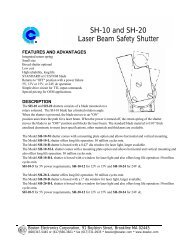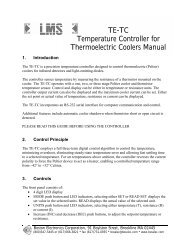SERIES PVI-2TE 2-12 µm IR PHOTOVOLTAIC DETECTORS ...
SERIES PVI-2TE 2-12 µm IR PHOTOVOLTAIC DETECTORS ...
SERIES PVI-2TE 2-12 µm IR PHOTOVOLTAIC DETECTORS ...
You also want an ePaper? Increase the reach of your titles
YUMPU automatically turns print PDFs into web optimized ePapers that Google loves.
VIGO System S.A.Mechanical AccessoriesDR-10B Set: Base (DRB-1) and Heat Sink (DR-10) forWide-Band Preamplifiers (>50 Mhz)Beam Power LimitationsFor devices without immersion lenses continuous workincident beam power must not exceed 100 W/cm 3 and pulsesshorter then 1 µs must not exceed 1 MW/cm 3 .For optically immersed devices continuous work incidentbeam power must not exceed 20 W/cm 3 and pulses shorterthen 1 µs must not exceed 10 kW/cm 3 .Saturation power density depend on a type of the detectorand can be provided upon request.Shaping LeadsAvoid bending the leads at a distance less then 2 mm froma base of the package not to damage the glass seals. Whenshaping the leads, do not exceed the following limits:– Maximal mechanical tension – 0.5 kg for 5 sec– Maximum two right angle bends and three twists at thedistance minimum 6 mm from the base of the packageWhen shaping the leads of the detector, short the leads ofthe detecting element with a special jumper.Soldering Leads<strong>IR</strong> Detectors can be easily damaged by excessive heat.Special care should be taken when soldering the leads. Usageof heat sinks is highly recommended. Tweezers can be usedfor this purpose; clamp a lead being soldered at a placebetween the soldering iron and the base of the case. To avoiddestructive influence of ESD and other accidental voltages(deriving for example from a non-grounded soldering iron)(e.g. on <strong>PVI</strong>-<strong>2TE</strong> detectors) all rules for handling LSIintegrated circuits should be applied to <strong>IR</strong> detectors too.DR-1B Set: Base (DRB-1) and Heat Sink (DR-1)Precautions for Use, WarrantyStorageThe following conditions should be fulfilled for the safeand reliable operation of detectors:– Storage temperature: -10ºC ÷ +50ºC– Avoiding ESD; detectors are very sensitive toelectrostatic discharges, therefore they should be storedhaving detection element’s leads shorted by a specialjumper.HandlingWindows of some detectors are made of very soft materialslike ZnSe or BaF 2. Particular attention should be paid to notscratch a surface of the window when some sharp tools arebeing used. A damaged window may entirely degrade thedetector’s performance. Excessive mechanical stress appliedto the package itself or to a device containing the package,may result in permanent damage of the latter.Cleaning WindowKeep the window clean. Use a soft cotton cloth dampedwith isopropyl alcohol and wipe off the surface gently ifnecessary.Mechanical ShocksThe Peltier elements may be damaged by the excessivemechanical shocks and vibrations. Great care isrecommended during all manipulations (including normalexploitation) to avoid the mentioned hazards. Drop impactsagainst a hard base may be particularly dangerous.Heat SinkingThe base of the package must be firmly attached to theheatsink. This can be achieved either by using a thin layer(



